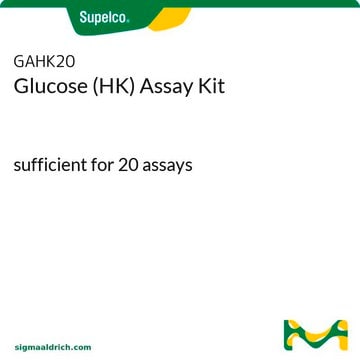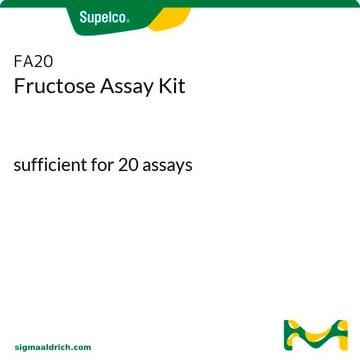G3293
Glucose-Assay-Reagenz
for use with enzymatic assay kits GAHK20, SCA20, FA20, SA20
About This Item
Empfohlene Produkte
chemische Klasse(n) des Analyten
sugars (glucose)
Methode(n)
photometry: suitable
Verunreinigungen
≤0.005% Creatine phosphokinase, glutathione reductase, myokinase, NADH-oxidase,NADPH oxidase, phosphogluconic dehydrogenase, phosphoglucose isomerase, lactic dehydrogenase
<0.01% ATP-ase, myokinase
Anwendung(en)
food and beverages
general analytical
Lagertemp.
2-8°C
Spezifität
Anwendung
Ähnliches Produkt
Lagerklassenschlüssel
11 - Combustible Solids
WGK
WGK 3
Flammpunkt (°F)
Not applicable
Flammpunkt (°C)
Not applicable
Persönliche Schutzausrüstung
Eyeshields, Gloves, multi-purpose combination respirator cartridge (US)
Analysenzertifikate (COA)
Suchen Sie nach Analysenzertifikate (COA), indem Sie die Lot-/Chargennummer des Produkts eingeben. Lot- und Chargennummern sind auf dem Produktetikett hinter den Wörtern ‘Lot’ oder ‘Batch’ (Lot oder Charge) zu finden.
Besitzen Sie dieses Produkt bereits?
In der Dokumentenbibliothek finden Sie die Dokumentation zu den Produkten, die Sie kürzlich erworben haben.
Kunden haben sich ebenfalls angesehen
Protokolle
Enzymatic Assay of α-Glucosidase by the Modified Boehenger Procedure (EC 3.2.1.20)
To standardize an enzymatic assay procedure of cellulase.
This procedure may be used for the determination of Amyloglucosidase activity using starch as the substrate.
Unser Team von Wissenschaftlern verfügt über Erfahrung in allen Forschungsbereichen einschließlich Life Science, Materialwissenschaften, chemischer Synthese, Chromatographie, Analytik und vielen mehr..
Setzen Sie sich mit dem technischen Dienst in Verbindung.






